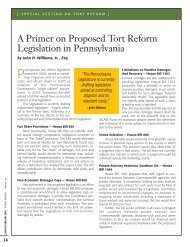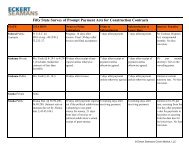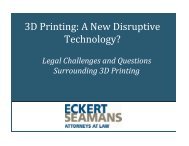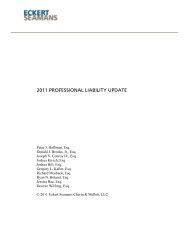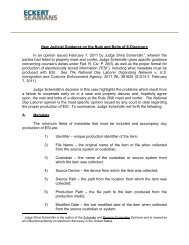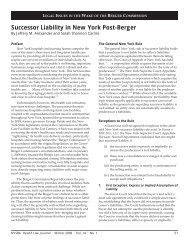2012 PROFESSIONAL LIABILITY UPDATE - Eckert Seamans
2012 PROFESSIONAL LIABILITY UPDATE - Eckert Seamans
2012 PROFESSIONAL LIABILITY UPDATE - Eckert Seamans
Create successful ePaper yourself
Turn your PDF publications into a flip-book with our unique Google optimized e-Paper software.
claims and cross-claims remain against the third party defendant had no bearing on Rule 1042.3.Accordingly, the third party defendant’s motion to dismiss was granted.In contrast, the District Court in Guynup v. Lancaster County Prison, No. 06-4315, 2007U.S. Dist. LEXIS 63412 (E.D. Pa. Aug. 17, 2007), held that where jurisdiction lies solely infederal question, Rule 1042.3 is inapplicable. Thus, a certificate of merit was not required.In Ward v. Knox, McLaughlin, Gornall & Sennett, No. 08-43 Erie, 2009 U.S. Dist.LEXIS 20302 (W.D. Pa. Mar. 13, 2009), the United States District Court for the Western Districtof Pennsylvania has held that Rule 1042.7 is procedural in nature and thus inapplicable to federalpractice. Because the Federal Rules of Civil Procedure do not provide for a judgment of nonpros, the proper procedure in federal court is to treat a motion to dismiss a professionalnegligence action for failure to comply with Rule 1042.3 as a motion to dismiss, withoutprejudice. But see, Liggon-Redding v. Estate of Robert Sugarman, 659 F. 3d 258 (3 rd Cir.2011).(iii)Expert TestimonyIn Quinn Construction, Inc. v. Skanska USA Building Inc., No. 07-406, 2009 U.S. Dist.LEXIS 45247 (E.D. Pa. May 27, 2009), the court addressed a defense motion for the preclusionof expert testimony, on the basis that the trial court ruled at an earlier stage that Plaintiff was notasserting a claim for professional liability. Plaintiff was a subcontractor who brought claimsagainst the general contractor and architect alleging negligent misrepresentation and breach ofcontract. The defense argued that based upon the comment to Rule 1042.3, Plaintiff cannotpresent expert testimony at the time of trial. The court explained that the comment to Rule1042.3 only addresses the situation where a plaintiff certifies that he/she is bringing a claim forprofessional liability, but that expert testimony is not required where the court finds that Plaintiffis bringing a claim for ordinary negligence. Plaintiff had not yet produced any expert reports, sothe court abstained from making any ruling on what expert testimony would be permitted at thetime of trial, noting Fed. R. Evid. 702 would govern the admission of such testimony. See alsoMcCool v. Department of Corrections, 2009 WL 3462498 (Pa. Commw. Ct. July 29, 2009),appeal denied, 742 A.2d 678 (Pa. 2009) (dismissing Plaintiff’s complaint when certificate ofmerit stated that expert testimony was not required and noting the damages of mastocytosis andesophageal dysphagia are complex and little known diseases requiring expert testimony).(iv)Dragonetti Act ClaimsIn Sabella v. Milides, 992 A.2d 180 (Pa. Super. 2010), appeal denied 9 A.3d. 631 (Pa.2010), the court addressed whether a Dragonetti claim against an attorney required the filing of acertificate of merit. The trial court ruled that the Dragonetti claim required a certificate of merit,finding that plaintiff’s allegations that defendant filed an unfounded complaint constituted anaverment that defendant deviated from an acceptable professional standard. Id. at 189. TheSuperior Court explained that the uncontested facts were that: (1) defendant’s actions wereconducted as an attorney at law; (2) plaintiff was never a client of defendant, and (3) plaintiff didnot meet the narrow exception to the general rule of privity. Id. The Superior Court noted thatbased upon the uncontroverted facts, “Pennsylvania law makes clear that [plaintiff] could not sue[defendant] for legal malpractice.” Id. (citations omitted). The Superior Court reversed the128



